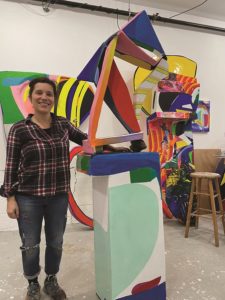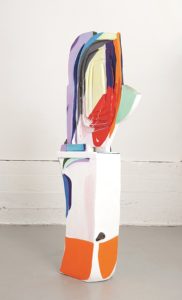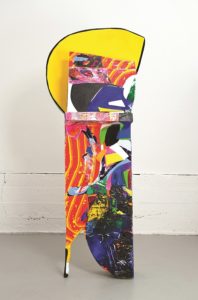Kristy Hughes thinks in planes. A printmaker by training who says she “avoided sculpture” throughout her studies, Hughes now makes towering, vibrant, multi-part sculptures, many of which started out as two-dimensional collages.

Born in Waxahachie, Texas, Hughes grew up in New Mexico and studied at Eastern Illinois University and Indiana University before moving to Georgia to teach at Valdosta State University. The experience of teaching, she says, created a “feeling of smallness” that caused her to begin to ask herself how to make things that “demanded agency” — and she realized she wanted her works to take up a different kind of space.
Given her lack of experience, Hughes’s work as a sculptor quite literally grew from the ground up. “I called up my friend who’s a sculptor and asked, ‘How do you make things stand up?’ ” she remembers.
But starting from scratch feels natural for Hughes, who says she comes from a long line of “builders and makers and fix-your-own-things” people. “This idea of being able to figure things out somehow seeped into how I make my work,” she says. And Hughes is not preoccupied by rules, if indeed there are any when it comes to making art. “Who cares if it’s not technically correct?” she says.
Hughes began working with discarded insulation foam that would otherwise have been thrown away. “The material is very forgiving,” she says. “It’s not precious, and I can build big.”
The pliability of insulation foam allows Hughes to embed it with objects that she does find precious. Driftwood from Race Point provides structural support in one of her most recent works, and rocks from Herring Cove are embedded in resin and fiberglass in another. There’s also string she found on MacMillan Wharf. “It’s always been super important to put things I’m finding around my immediate environment into the work,” Hughes says.
After shaping the foam, Hughes covers it with a layer of fiberglass. “I watched a lot of boating videos for fiberglass information,” she says, explaining that her process is akin to surfboard-making. She then paints the fiberglass in swaths and spots of bright hues. Hughes says she’s averse to color schemes and “usually gets hooked on a color and goes from there.”

This method of working with color is evident in Panoply, a piece she made this year in which cascading waves of red and yellow circumscribe blocks of almost every color. Hughes says she started by painting the red and yellow — and then “just reacted to it.” In another work, Shape of a Rock (Heart), on view in a current show at PAAM, the dominant pinks and purples draw from Outer Cape skies, which remind Hughes of colors in the New Mexican landscape.
As enthralling as Hughes’s sculptures are on the surface, much of the meaning with which they’re infused isn’t immediately visible. “Almost all the pieces have quotes or what I’m thinking about sealed inside,” she says. Preserved in the plaster of her most recent piece is a quotation from Maya Angelou that ends, “Home is between your teeth.”

“What I’m trying to do is force meaning into the work,” Hughes says. “I’m thinking about these things, so I want to literally embed them into it.” While sealing quotes into her sculptures has become part of the ritual of her work, she was shaken when she noted the undeniably ceremonial nature of the process.
“I’m not religious anymore, but I come from a very religious upbringing,” she says, adding, “I just got really burned by religion.” But with the passing of time, Hughes has realized that ritual and blessings are woven into the fabric of how she makes her work.
For many years, Hughes was able to dedicate only one day a week to studio time on top of the 15 minutes of working on art that she was able slip in between classes. This summer, she’ll continue work as the residency coordinator for the Elizabeth Murray Artist Residency in Troy, N.Y. and will teach art at the University of Vermont in Burlington come fall. Until then, she says, her FAWC fellowship opportunity has been a “dreamy” experience.
“To have day after day after month of studio time is the best ever,” she says. “I can let things simmer and really think about them.”
And spending time with writers has been its own gift: “They understand words like I understand color,” Hughes says. Two buoys are perched in one corner of her studio, each given to her by a FAWC writing fellow who came across it and thought of her work. Bright strips of color on each bear an uncanny resemblance to one of Hughes’s sculptures.
To the extent that Hughes sees FAWC as the site of cross-disciplinary understanding, it comes years into her realization about the powers of art as a tool of communication. Hughes, who has dyslexia, says that she felt “very cactus-tongued” for much of her life. But making sculptures has proven an antidote to the frustration of being congested with words and ideas that she couldn’t express.
“I couldn’t say what I wanted to say,” she says. “But now it feels like whatever I was trying to say is finally in the world.”
Fellow Friday
The event: A showcase featuring new work by visual art fellows Yahna Harris and Kristy Hughes and writing fellows Clarisse Baleja Saidi and Kieron Walquist
The time: Friday, March 17, 5 to 8 p.m.
The place: Fine Arts Work Center, 24 Pearl St., Provincetown
The cost: Free. See fawc.org for information.



